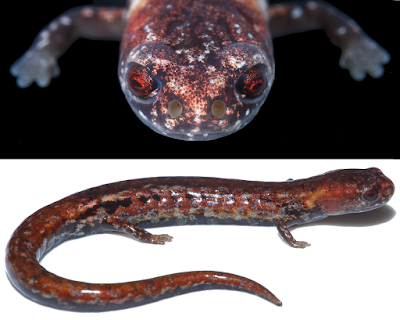[Most Recent Entries] [Calendar View]
Saturday, January 20th, 2018
| Time | Event | ||||
| 7:53a | [Herpetology • 2018] Nototriton costaricense • A New Moss Salamander, Genus Nototriton (Caudata: Plethodontidae), from the Cordillera de Talamanca, in the Costa Rica-Panama Border Region
Abstract A new salamander belonging to the genus Nototriton, subgenus Nototriton, is described from the Caribbean slopes of the southeastern Cordillera de Talamanca in Costa Rica, within Parque Internacional La Amistad, at an elevation ca. 1500 m a.s.l. This new taxon is distinguished from its congeners by its morphological characteristics and by its differentiation in DNA sequences of the 16S rRNA, cytochrome oxidase subunit I (COI), and cytochrome b mitochondrial genes. This new species represents the southernmost extension known for the genus Nototriton. Keywords: Amphibia, caudate, Central America, Nototriton picadoi species group, Talamanca 
Nototriton costaricense sp. nov. Southern Moss Salamander .... Etymology. The specific epithet refers to the Spanish word meaning Costa Rican, “costaricense”. The name represents the fact that the holotype and species was discovered in Costa Rica. Given the close proximity of the type locality to the Costa Rica-Panama border, we speculate that one day it may indeed be discovered within Panama as well. ResearchGate.net/publication/322308710_A A new species of Moss Salamander CRAmphibian.com/2018/01/15/a-new-species-o twitter.com/frogs_friends/status/9532632  | ||||
| 8:07a | [Botany • 2018] Alseodaphnopsis: A New Genus of Lauraceae based on Molecular and Morphological Evidence
Abstract An investigation of a questionable species of the genus Alseodaphne led to the discovery of a new genus Alseodaphnopsis H. W. Li & J. Li, gen. nov., separated from Alseodaphne Nees, and a new species Alseodaphnopsis ximengensis H. W. Li & J. Li, sp. nov., endemic to Yunnan province, China. This new species is characterized by having big, axillary, paniculate inflorescences, as well as large, subglobose fruits. Based on DNA sequence data from two gene regions (nuclear ribosomal ITS and LEAFY intron II), we investigate its phylogenetic position within the Persea group. Phylogenies using maximum parsimony (MP) and Bayesian inference (BI) support the recognition of Alseodaphnopsis as a distinct genus but do not resolve well its relationship within the Persea group. The new genus is circumscribed, eight new combinations for its species are made, and a description and illustration of the new species are provided. Alseodaphnopsis H. W. Li & J. Li, gen. nov. Type: Alseodaphnopsis petiolaris (Meisn.) H. W. Li & J. Li (Nothaphoebe petiolaris Meisn., here designated) Diagnosis: The new genus Alseodaphnopsis H. W. Li et J. Li is obviously very close to the genus Alseodaphne Nees (s. str.), but differs from the latter morphologically by 1) twigs thick, 4–11 mm in diam., and not obviously whitish in color; 2) terminal buds usually perulate; 3) perianth lobes ± persistent at least in young fruit; 4) inflorescences relatively large, 8.5–35 cm long, many-flowered, with 3–4 orders of branching; 5) fruits medium to large size (3–5 cm), without ribs. Etymology: Alseodaphnopsis alludes to the resemblance to traditional Alseodaphne (s. str.) Distribution and habitat: Alseodaphnopsis includes nine species, mainly distributed in the northern marginal part of the tropical zone in southwestern China, but extending also to NE India, Laos, Myanmar, Thailand and Vietnam. As far as it is known, the species grow preferentially in forests on limestone mountains. New combinations. Here, we make eight new combinations for the species in this new genus as follows: 1) Alseodaphnopsis andersonii (King ex Hook. f.) H. W. Li & J. Li, comb. nov. Distributed in China (SE & S Yunnan, SE Xizang); NE India, Laos, Myanmar, Thailand and Vietnam. 2) Alseodaphnopsis petiolaris (Meisn.) H. W. Li & J. Li, comb. nov. Distributed in China (S Yunnan); India and Myanmar. 3) Alseodaphnopsis sichourensis (H. W. Li) H. W. Li & J. Li, comb. nov. Distributed in China (SE Yunnan). 4) Alseodaphnopsis marlipoensis (H. W. Li) H. W. Li & J. Li, comb. nov. Distributed in China (SE Yunnan). 5) Alseodaphnopsis rugosa (Merr. & Chun) H. W. Li & J. Li, comb. nov. Distributed in China (Hainan, SE Yunnan). 6) Alseodaphnopsis hainanensis (Merr.) H. W. Li & J. Li, comb. nov. Distributed in China (Hainan); N Vietnam. 7) Alseodaphnopsis hokouensis (H. W. Li) H. W. Li & J. Li, comb. nov. Distributed in China (SE Yunnan). 8) Alseodaphnopsis lanuginosa (Kosterm.) H. W. Li & J. Li, comb. nov. Distributed in N Vietnam. Alseodaphnopsis ximengensis H. W. Li & J. Li, sp. nov. Type: China. Yunnan Province: Pu’er City, Ximeng County, ca. 1300 m altitude, in seasonal rain forest, 20 November 2011, J. W. Li 1235 (fl.) (Holotype, Isotypes: HITBC!). Diagnosis: This new species shows a superficial similarity to Alseodaphnopsis petiolaris (Meisn.) H. W. Li & J. Li in its big leaves and elongated petioles, but differs by its glabrous twigs, leaves and panicles as well as subglobose big fruit. Yue-qing Mo, Lang Li, Jian-wu Li, Jens G. Rohwer, Hsi-wen Li and Jie Li. 2018. Alseodaphnopsis: A New Genus of Lauraceae based on Molecular and Morphological Evidence. PLoS ONE. 12(10): e0186545. DOI: 10.1371/journal.pone.0186545 |
| << Previous Day |
2018/01/20 [Calendar] |
Next Day >> |


